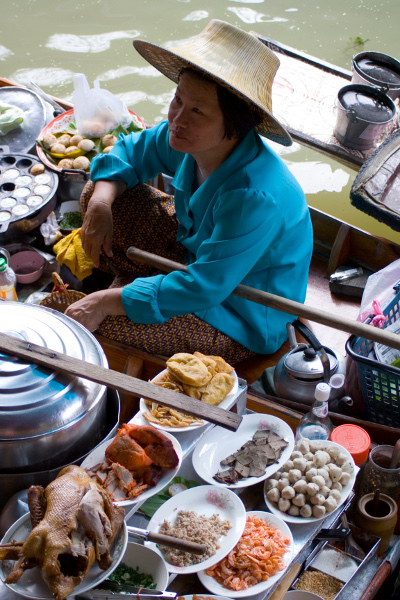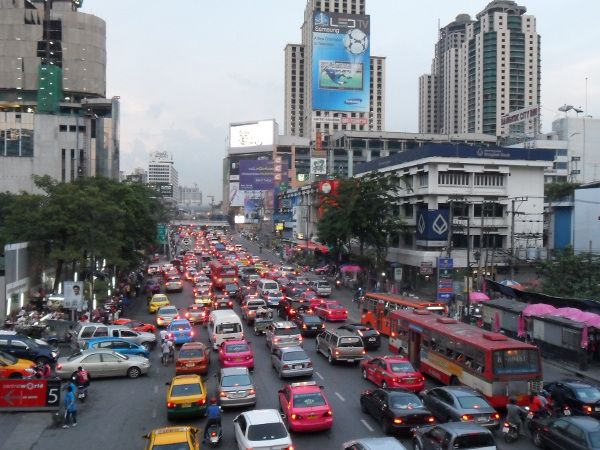
Bangkok is a city that has seen a dramatic transformation over the last 25 years from a third world city to a thriving hub of culture with a growing economy. Unlike London, Tokyo, or New York, Bangkok is new in its position in global finance and business and is sure to experience some growing pains. Having lived in Bangkok for a year, it was easy for me to see both what Bangkok has to learn from more established cities and what cities like New York can learn from this emerging international capital.
Defining Bangkok
I always told friends visiting Bangkok that they would understand the city by the time they got to my apartment from the airport.Arriving in beautiful and well organized Suvarnabhumi Airport, you are greeted with short immigration lines and luxury amenities ranging from car services to people who will carry your luggage. If you take the well air-conditioned Air Tran, you will feel like you have arrived in the future on your way to the city center.Outside of the airport, however, it’s a different scene. The taxi line is filled with brightly colored taxis and tuk-tuk drivers vying for your business with tricks and scams. The sights of impoverished neighborhoods and run down housing during the 30-minute ride will remind you there is still progress to be made in “the land of smiles.”
Bangkok’s Appeal
Bangkok is the third most visited city in the world with 12.2 million visitors spending $19.3 billion every year – just behind New York’s annual tourism revenue of $19.4 billion. After exploring and getting to know the city, it is easy to see why. It is a city rich in culture, offering a unique mix of the old and new world. Thailand’s culture is dispersed through the city’s neighborhoods, with Western influences and tastes filtering in from around the globe. Along with this diversity however, comes a plague of economic gaps which can be seen in every neighborhood. The financial districts in in Silom, Asok, and Ekkamai are bustling centers of trade, yet venturing off the beaten path will surely lead you to homes built to questionable standards and lacking the modern day conveniences taken for granted in a developed city.That is not to say that Bangkok as a whole is not world class. The city is home to some of the highest rated rooftop restaurants and bars in the world, notably Lebua at State Tower and RedSky at Centara Grand and Central World. Some of the best museums in Asia are located in the city, as are a number of unique tourist attractions. Stores selling items by international designers like Jimmy Choo, Marc Jacobs, and Rolex are as common as sprawling flea markets, such as Chatuchak’s famous weekend market – a bargain hunter’s dream. Thailand’s modern culture, focused on image, fashion, and prosperity, is apparent in advertising, shopping centers and all aspects of everyday life.In addition to tourists, Bangkok also appeals to many global companies, with multi-national corporations choosing to base their Southeast Asian presence in the city’s financial district. A short drive south of Bangkok will take you to the “Detroit of the East,” where automotive manufacturing has become an industry so large that Thailand is now the 7th largest exporter of cars in the world.It is not really a surprise that the economy has grown as it has; after Asia’s financial crisis in 1997, the country became largely unregulated and was very friendly to outside investment. Manufacturers were able to enter the marketplace without a local partner and the government offered generous tax incentives to foreign investors.
Along with this diversity however, comes a plague of economic gaps which can be seen in every neighborhood. The financial districts in in Silom, Asok, and Ekkamai are bustling centers of trade, yet venturing off the beaten path will surely lead you to homes built to questionable standards and lacking the modern day conveniences taken for granted in a developed city.That is not to say that Bangkok as a whole is not world class. The city is home to some of the highest rated rooftop restaurants and bars in the world, notably Lebua at State Tower and RedSky at Centara Grand and Central World. Some of the best museums in Asia are located in the city, as are a number of unique tourist attractions. Stores selling items by international designers like Jimmy Choo, Marc Jacobs, and Rolex are as common as sprawling flea markets, such as Chatuchak’s famous weekend market – a bargain hunter’s dream. Thailand’s modern culture, focused on image, fashion, and prosperity, is apparent in advertising, shopping centers and all aspects of everyday life.In addition to tourists, Bangkok also appeals to many global companies, with multi-national corporations choosing to base their Southeast Asian presence in the city’s financial district. A short drive south of Bangkok will take you to the “Detroit of the East,” where automotive manufacturing has become an industry so large that Thailand is now the 7th largest exporter of cars in the world.It is not really a surprise that the economy has grown as it has; after Asia’s financial crisis in 1997, the country became largely unregulated and was very friendly to outside investment. Manufacturers were able to enter the marketplace without a local partner and the government offered generous tax incentives to foreign investors.
International Living
Moving to New York from Bangkok was eye opening. In Bangkok, $700 USD afforded a 2-bedroom luxury apartment with a view of the skyline, indoor and outdoor pool and fitness facilities, laundry and doorman service, and a balcony 40 stories above the hectic Bangkok streets. In New York, the same will get you a walk up apartment in an up-and-coming area of Brooklyn or Queens. Needless to say, there is no doorman and I am yet to find the rooftop pool.This same quality of life is further expressed in the Bangkok’s extravagant theaters, restaurants and shopping outlets. While most local Thai people can’t afford to drop what a New Yorker would consider average on a $30 dinner, doing so in Bangkok will take you to four or five star restaurants with sweeping views and impeccable service. Your $15 movie ticket will get you gourmet popcorn, massaging chairs and a bartender to mix your cocktails to order.Foreigners (or “Farangs” in Thai lingo) live all types of lives in Thailand from “living like the locals” to living in luxury apartments with maids, drivers, and impressive facilities.
Although internationals living in Bangkok have a much higher standard of living than those earning the same money in New York, it comes with the downside that Thai locals, in general, cannot afford the same quality of life. The international community generally makes far more than their local equivalents, and although there are clearly ethical issues on the fairness of this practice, there is an awkward acceptance of the inequality. In comparison, New York’s equal opportunity laws aim to protect foreigners and locals by stating that discriminating based on race or country of origin is illegal. Of course, as with any law, they are often broken and some internationals may find that unfortunately they are paid less than their American coworkers. If the inequality issue isn’t a concern for you, Bangkok is far more affordable place to call home for the international community.Just how many internationals are in Bangkok? Thailand’s census borough doesn’t require identification by race and many of the country’s internationals work in the country illegally, making the actual number hard to identify. Estimates are well over 20% of the city’s metropolitan population of 14 million, but officially it is a fraction of that. From English teachers to skilled workers, people from around the world call Bangkok home.
Learning from Bangkok
Although New York is certainly a more established city, there are a number of things that it could learn from Bangkok’s position as a growing international hub.Bangkok’s transit systems are by far cleaner, more efficient and generally a more enjoyable experience than those offered by New York. Being below sea level and prone to flooding, Bangkok operates an extensive elevated train system, the SkyTrain, through the city’s center to avoid issues when common flash flooding occurs. An idea New York could look to as a possible solution for future disasters like Superstorm Sandy. The city also utilizes a convenient tap card system for paying at stations; this could certainly save time and reduce congestion at busy stations such as Grand Central Terminal. Bangkok’s airport is easy to navigate, beautifully designed, and offers an incredibly efficient immigration system when compared to New York’s airports. Being one of the largest transportation hubs in Southeast Asia, this single airport manages to run a much faster immigration process than the three airports servicing New York.This is not to say that New York cannot teach growing Bangkok a few lessons. Bangkok is riddled with legendary traffic jams which immobilize the city. These same traffic jams also make Bangkok one of the most polluted cities in the world; a common lament among internationals was that breathing Bangkok’s air on a daily basis was like smoking two packs of cigarettes a day.Using New York’s traffic system and toll structure as a model could be an easy way to limit the number of cars on the streets and minimize the emissions in the city. New York’s use of hybrid buses and taxis is another notable example of how Bangkok could improve the air quality.With the growing importance of Asian countries among the global market, Bangkok is well on its way to becoming one of the world’s most important cities. Looking at what other major cities have done to build infrastructure and support sustainable growth will give Bangkok the help it needs to continue to grow as a hub of tourism, economic activity and culture well into the future.
Bangkok’s airport is easy to navigate, beautifully designed, and offers an incredibly efficient immigration system when compared to New York’s airports. Being one of the largest transportation hubs in Southeast Asia, this single airport manages to run a much faster immigration process than the three airports servicing New York.This is not to say that New York cannot teach growing Bangkok a few lessons. Bangkok is riddled with legendary traffic jams which immobilize the city. These same traffic jams also make Bangkok one of the most polluted cities in the world; a common lament among internationals was that breathing Bangkok’s air on a daily basis was like smoking two packs of cigarettes a day.Using New York’s traffic system and toll structure as a model could be an easy way to limit the number of cars on the streets and minimize the emissions in the city. New York’s use of hybrid buses and taxis is another notable example of how Bangkok could improve the air quality.With the growing importance of Asian countries among the global market, Bangkok is well on its way to becoming one of the world’s most important cities. Looking at what other major cities have done to build infrastructure and support sustainable growth will give Bangkok the help it needs to continue to grow as a hub of tourism, economic activity and culture well into the future.
